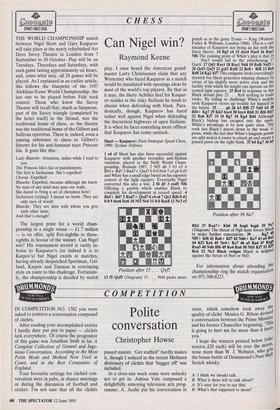Can Nigel win?
Raymond Keene
THE WORLD CHAMPIONSHIP match between Nigel Short and Gary Kasparov will take place at the newly refurbished Art Deco Savoy Theatre in London from 7 September to 30 October. Play will be on Tuesdays, Thursdays and Saturdays, with each game lasting approximately six hours, and, come what may, all 24 games will be played. As I explained in an earlier article, this follows the blueprint of the 1937 Alekhine-Euwe World Championship, the last one to be played before Fide took control. Those who know the Savoy Theatre will recall that, much as Simpsons, part of the Savoy triangle (completed by the hotel itself) in the Strand, was the traditional home of chess, so the theatre was the traditional home of the Gilbert and Sullivan operettas. There is, indeed, even a passing reference to chess in Gilbert's libretto for his anti-feminist tract Princess Ida. It goes like this:
Lady Blanche: Attention, ladies while I read to you The Princess Ida's list of punishments.
The first is Sacharissa. She's expelled!
Chorus: Expelled!
Blanche: Expelled, because although she knew No man of any kind may pass our walls, She dared to bring a set of chessmen here!
Sacharissa (crying): I meant no harm. They are only men of wood!
Blanche: They are men with whom you give each other mate, And that's enough!
The largest prize for a world cham- pionship in a single venue — £1.7 million — is on offer, split five-eighths to three- eighths in favour of the winner. Can Nigel win? His tournament record is vastly in- ferior to Kasparov's (as indeed it is to Karpov's) but Nigel excels at matches, having already despatched Speelman, Gel- fand, Karpov and Timman in convincing style en route to this challenge. Fortunate- ly, the championship is decided by match play. I once heard the American grand- master Larry Christiansen claim that any Westerner who faced Kasparov in a match would be inundated with openings ideas by most of the world's top players. Be that as it may, the likely Achilles heel for Kaspar- ov resides in the risky Sicilians he tends to choose when defending with black. Para- doxically, though, Kasparov has fared rather well against Nigel when defending the theoretical highways of open Sicilians. It is when he faces something more offbeat that Kasparov has come unstuck.
Short — Kasparov: Paris Immopar Speed Chess, 1990: Sicilian Defence.
1 e4 c5 Short has also been successful against Kasparov with another recondite anti-Sicilian variation, played in the Swift World Cham- pionship, Brussels 1987: 2 Nf3 d6 3 b3 e5 4 Bb5+ Bd7 5 Bxd7+ Qxd7 6 0-0 Nc6 7 c4 g6 8 d3 and White has a small edge based on his superior control of the liglp squares. Eventually Nigel converted this into a win. 2 14 d5 3 exd5 Nf6 Offering a gambit which enables Black to complete his development at record speed. 4 Bb5+ Bd7 5 Bxd7+ Qxd7 6 c4 e6 7 Qe2 Bd6 8 d3 0-0 9 dxe6 fxe6 10 Nf3 Nc6 11 0-0 Rae8 12 Nc3 e5
Position after 13 . . . Qxf5
13 f5 Qxf5 (Diagram) 13 . . . Nd4 packs more
punch as in the game Evans — King (Watson, Farley & Williams, London 1988). This is a rare instance of Kasparov not being au fait with the latest theory. 14 Bg5 e4 15 dxe4 Nxe4 16 Rael Nf6 The cunning point of White's play is that 16 . . . Nxc3 would fail to the zwischenzug 17 Qxe8. 17 Qdl Rxel 18 Rxel Nd4 19 Bxf6 Nxf3+ 20 Qxf3 Qxf3 21 gxf3 Rxf6 22 Re8+ Rf8 23 Re6 Rd8 24 Kg2 Kf7 This endgame looks exceedingly drawish but Short generates winning chances by virtue of his slightly more active rook and the facility with which his knight can operate on the central light squares. 25 Re4 In response to this Black should play 25 . . . Re8 seeking to trade rooks. By failing to challenge White's mobile rook Kasparov stores up trouble for himself in the future. 25 . . . g6 26 b3 Bf8 27 Nd5 b5 28 Rf4+ Kg7 29 1013 bxc4 30 bxc4 Rb8 31 Rf6 Rb7 32 Ra6 Kr 33 f4 Bg7 34 Kg4 Bd4 Although Black's bishop has escaped into the oin, White's advantage is by now quite clear. The rook ties Black's pieces down to the weak `a' pawn, while the fact that White's kingside pawns are split makes it easier to attack g6 and create a passed pawn on the right flank. 35 h4 Kg7 36 b5 Position after 39 Ne7 Rb2 37 Rxa7+ Kh6 38 hxg6 hxg6 39 Nei (Diagram) The threat of Ng8 mate forces Black to make further concessions. 39 . . . Kg7 ,46 NfS+ Kf6 41 Ra6+ Kf7 42 Nd6+ Ke7 43 a4 4.4 1Kf3 Ke6 45 Ne4+ Ke7 46 a5 Ra4 47 Rxa5 48 Nd6 Bf6 49 Ke4 Ra6 50 Nb5 1(17 51 Rc6 52 Nc3 Black resigns Black is helpless against the threat of Ne4 or Nd5.
For information about attending the championship ring the match organisation on 071-388-8223.


































































 Previous page
Previous page